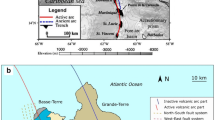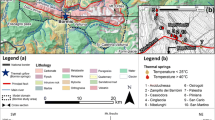Abstract
The geothermal site of Lavey-les-Bains, Switzerland is an Alpine deep flow system in fractured crystalline rocks. Groundwater analyses since 1973 reveal a mixing process between a deep warm component (68°C and TDS 1.4 g/L) and cold shallow water. The production rate of the new deep well P600, installed in 1997, has amplified this mixing process in well P201, for which a decline in temperature and TDS has been observed. Numerical hydrogeological two-dimensional and three-dimensional models of heat, flow and mass transport have been developed to reproduce the geothermal system and to forecast the long-term exploitation potential of the geothermal resource. The computed temperature of the deep inferred reservoir (100–130°C) is in agreement with the geothermometers, whereas the simulated thermal water flux (5,400–9,000 m3/day) is probably underestimated. Different fluid production scenarios can reproduce the decline and stabilization phases of temperatures in the geothermal field since 1997. For P201, the mixing ratio calculated before and during the exploitation of P600 is comparable with observed data; the modelled temperature tends towards stabilization in P201 at 56°C after 10–15 years of production at P600. Another proposed new well is likely to reduce the thermal output of the existing wells.
Résumé
Le site géothermal de Lavey-les-Bains (Suisse) est un système alpin d’écoulement profond dans des terrains cristallins fracturés. Les analyses acquises depuis 1973 sur les eaux souterraines montrent un processus de mélange entre une composante profonde et chaude (68°C et TDS 1.4 g/L) et une eau froide peu profonde. La production sur le nouveau puits profond P600, réalisé en 1997, a amplifié ce processus de mélange dans le puits P201, où une baisse de la température et des TDS a été observée. Des modèles numériques 2D et 3D de chaleur, d’écoulement et de transport de masse ont été développés pour reproduire le système géothermal et pour prédire le potentiel de ressource géothermique exploitable à long terme. La température calculée du réservoir profond induit (100–130°C) est en accord avec les géothermomètres alors que le flux d’eau thermale (5,400–9,000 m3/jour) est probablement sous-estimé. Plusieurs scénarios de production de fluide permettent de reproduire les phases de baisse et de stabilisation des températures dans le champ géothermal depuis 1997. Sur P201, le rapport de mélange calculé avant et pendant l’exploitation de P600 est comparable aux valeurs observées; la température modélisée sur P201 tend vers une stabilisation à 56 C après 10–15 ans de production sur P600. La proposition d’un nouveau puits est susceptible de réduire la production thermale des puits existants.
Resumen
El sitio geotérmico de Lavey-les-Bains, Suiza es un sistema de flujo profundo Alpino en rocas cristalinas fracturadas. Los análisis de las aguas subterráneas desde 1973 revelan un proceso de mezcla entre una componente de agua caliente profunda (68 C y TDS 1.4 g/L) y agua fría somera. El ritmo de producción del nuevo pozo profundo P600, instalado en 1997, ha amplificado este proceso de mezcla en el pozo P201, en el cual se ha observado una disminución en la temperatura y en los TDS. Se han desarrollado modelos numéricos hidrogeológicos 2D y 3D de transporte de calor, flujo y masa para reproducir el sistema geotérmico y pronosticar la potencial explotación a largo plazo del recurso geotérmico.La temperatura calculada del reservorio profundo inferido (100–130°C) esta de acuerdo con los geotermómetros, mientras que el flujo simulado de agua termal simulada (5,400–9,000 m3/d) está probablemente subestimado. Diferentes escenarios de producción de fluido pueden reproducir las fases de disminución y estabilización de la temperatura en el campo geotérmico desde 1997. Para el pozo P201, la relación de mezcla calculada antes y durante la explotación de P600 es comparable con los datos observados, la temperatura modelada tiende hacia la estabilización en el P201 en 56 C después de 10–15 años de producción del P600. Otro pozo nuevo propuesto pozos probablemente reduzca la producción tércmica de los pozos existentes.
Resumo
O sítio geotérmico de Lavey-les-Bains, Suíça é um sistema de circulação profunda Alpino em rochas cristalinas fracturadas. Análises de águas subterrâneas efectuadas desde 1973 revelam um processo de mistura entre um componente profundo e quente (68°C e SDT de 1.4 g/L) e água fria de baixa profundidade. O regime de exploração da nova captação profunda P600, instalada em 1997, tem intensificado este processo de mistura na captação P201, onde foi observada uma diminuição na temperatura e nos SDT. Foram desenvolvidos modelos hidrogeológicos numéricos 2D e 3D de calor, fluxo e transporte de massa para reproduzir o sistema geotérmico e prever o potencial de exploração do recurso geotérmico a longo prazo. A temperatura calculada do inferido reservatório profundo (100–130°C) está de acordo com os geotermómetros, enquanto que o fluxo de água termal simulado (5,400–9,000 m3/d) se encontra provavelmente subestimado. Diferentes cenários de produção de fluidos conseguem reproduzir as fases de diminuição e estabilização de temperaturas no campo geotérmico desde 1997. Para P201, a razão de mistura calculada antes e durante a exploração do P600 é comparável com dados observados; a temperatura modelada no P201 tende a estabilizar nos 56°C, após 10–15 anos de produção no P600. Uma outra nova captação proposta provavelmente irá reduzir a produção térmica das captações existentes.














Similar content being viewed by others
References
André L, Rabemanana V, Vuataz FD (2006) Influence of water–rock interactions on fracture permeability of the deep reservoir at Soultz-sous-Forêts, France. Geothermics 35(5):507–531
Besson O, Marchant R, Pugin A, Rouiller JD (1993) Campagne de sismique-réflexion dans la vallée du Rhône entre Sion et Saint-Maurice: perspectives d’exploitation géothermique des dépôts torrentiels sous-glaciaires [Seismic-reflection investigation in the Rhone Valley between Sion and Saint-Maurice: prospects for geothermal exploitation of the subglacial torrential deposits]. Bull CHYN 12:39–58
Bianchetti G (1994) Hydrogéologie et géothermie de la région de Lavey-les-Bains (Vallée du Rhône, Suisse) [Hydrogeological and geothermal characteristics of the Lavey-les-Bains area (Rhone Valley, Switzerland)]. Bull Hydrogéol 13:3–32
Clark SP, Niblett ER (1956) Terrestrial heat flow in the Alps. Mon Not R Astro Soc 7:176–195
Cruchet M (1985) Influence de la décompression sur le comportement hydrogéologique des massifs cristallins en Basse Maurienne (Savoie, France) [Influence of the decompression on the hydrogeological behaviour in the Basse Maurienne crystalline Massifs (Savoy, France)]. Géol Alp 61:65–73
Dobson PF, Salah S, Spycher N, Sonnenthal EL (2004) Simulation of water–rock interaction in the Yellowstone geothermal system using TOUGHREACT. Geothermics 33(4):493–502
Flores-Márquez EL, Jiménez-Suárez G, Martínez-Serrano RG, Chávez RE, Silva Pérez D (2006) Study of geothermal water intrusion due to groundwater exploitation in the Puebla Valley aquifer system, Mexico. Hydrogeol J 14(7):1216–1230
Gevrek AI (2000) Water/rock interaction in the Kizilcahamam Geothermal Field, Galatian Volcanic Province (Turkey): a modelling study of a geothermal system for reinjection well locations. J Volcanol Geotherm Res 96(3–4):207–213
Högl O (1980) Die Mineral- und Heilquellen der Schweiz [Mineral and thermal resources in Switzerland]. Haupt, Bern, Switzerland, 302 pp
Kohl T, Evans KF, Hopkirk RJ, Rybach L (1995) Coupled hydraulic, thermal and mechanical considerations for the simulation of hot dry rock reservoirs. Geothermics 24(3):345–359
Kolditz O, Clauser C (1998) Numerical simulation of flow and heat transfer in fractured crystalline rocks: application to the Hot Dry Rock site in Rosemanowes (U.K.). Geothermics 27(1):1–23
Kühn M, Stöfen H (2004) A reactive flow model of the geothermal reservoir Waiwera: New Zealand. Hydrogeol J 13(4):606–626
Leaver JD, Unsworth CP (2007) System dynamics modelling of spring behaviour in the Orakeikorako geothermal field, New Zealand. Geothermics 36(2):101–114
Lhomme D, Dzikowski M, Nicoud G, Payraud B, Fudral S, Guillot PL (1996) Les circulations actives des eaux souterraines des massifs cristallins alpins: exemple des Aiguilles Rouges (Haute-Savoie, France) [Groundwater circulation systems of Alpine crystalline massifs: the Aiguilles Rouges case]. CR Acad Sci Paris 323(2):681–688
Maréchal JC (1998) Les circulations d’eau dans les massifs cristallins alpins et leur relations avec les ouvrages souterrains [Water circulations in the Alpine crystalline massifs and their relations with tunnels]. Paper no. 1769, EPFL, Lausanne, Switzerland, 296 pp
Maréchal JC (1999) Observation des massifs cristallins alpins au travers des ouvrages souterrains. Définition du rôle hydrogéologique de la zone décomprimée [Observation of Alpine crystalline massifs through tunnels: definition of the hydrogeological role of the decompressed zone]. Hydrogéologie 1:33–42
McDermott CI, Randriamanjatosoa ARL, Tenzer H, Kolditz O (2006) Simulation of heat extraction from crystalline rocks: the influence of coupled processes on differential reservoir cooling. Geothermics 35(3):321–344
Medici F, Rybach L (1995) Geothermal map of Switzerland 1995 (Heat flow density), Matér géol Suisse, Géophys 30:1–36
Nicholson K (1993) Geothermal fluids: chemistry and exploration techniques. Springer, Berlin, 263 pp
Parriaux A, Nicoud G (1993) Les formations glaciaires et l’eau souterraine [Glacial formations and groundwater]. Quaternaire 4(2–3):61–67
Pfiffner OA, Lehner P, Heitzmann P, Mueller S, Steck A (1997) Deep structure of the Swiss Alps. Results of NRP 20. Birkenhaüser, Basel, Switzerland, 380 pp
Porras EA, Tanaka T, Fujii H, Itoi R (2007) Numerical modeling of the Momotombo geothermal system, Nicaragua. Geothermics 36(4):304–329
Pruess K (2006) Enhanced geothermal systems (EGS) using CO2 as working fluid: a novel approach for generating renewable energy with simultaneous sequestration of carbon. Geothermics 35(4):351–367
Sonney R, Vuataz FD (2008) Properties of geothermal fluids in Switzerland: a new interactive database. Geothermics 37(5):496–509
Teng Y, Koike K (2007) Three-dimensional imaging of a geothermal system using temperature and geological models derived from a well-log dataset. Geothermics 36(6):518–538
VDI-Richtlinien (2000) Thermal use of the underground: fundamentals, approvals and environmental aspects, part 1. VDI4640, Beuth, Berlin, 32 pp
Von Raumer JF, Bussy F (2004) Mont Blanc and Aiguilles Rouges geology of their polymetamorphic basement: external massifs, Western Alps, France-Switzerland. Mém Géol (Lausanne) 42, 203 pp
Vuataz FD (1982) Hydrogéologie, géochimie et géothermie des eaux thermales de Suisse et des régions alpines limitrophes [Hydrogeological, geochemical and geothermal characteristics of thermal waters in Switzerland and the bordering Alpine areas]. Matér Géol Suisse, Sér Hydrol 29:174
Zahner P, Mautner J, Badoux H (1974) Etude hydrogéologique des sources thermominérales de Lavey, d’Yverdon et de Saxon [Hydrogeological study of mineral and thermal springs of Lavey, Yverdon and Saxon]. Mém Soc Vaud Sci Nat 95(15):209–234
Acknowledgements
Special thanks are given to G. Bianchetti (Alpgeo Ltd.) for providing data for the studied site and for his agreement to quote the AGEPP project in this report. We also address our sincere gratitude to Prof. Pierre Perrochet, from the Swiss Center for Hydrogeology (CHYN University of Neuchâtel, Switzerland), who validated the concepts and results of the numerical modelling.
Author information
Authors and Affiliations
Corresponding author
Rights and permissions
About this article
Cite this article
Sonney, R., Vuataz, FD. Numerical modelling of Alpine deep flow systems: a management and prediction tool for an exploited geothermal reservoir (Lavey-les-Bains, Switzerland). Hydrogeol J 17, 601–616 (2009). https://doi.org/10.1007/s10040-008-0394-y
Received:
Accepted:
Published:
Issue Date:
DOI: https://doi.org/10.1007/s10040-008-0394-y




